Blog
What Do Cracked Heels Mean?
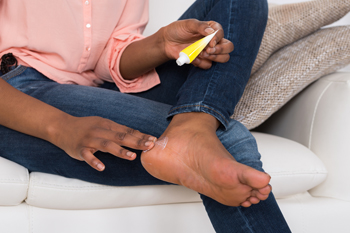
When an individual develops cracked heels, they might notice several things. First, they might see deep cracks, or fissures, on the back of the heel due to a lack of moisture. Second, although many cases are painless, severe cases of cracked heels can be accompanied by pain. Importantly, a case of cracked heels might signal other potential problems to be aware of. It is possible that heel fissures might point to some kind of vitamin deficiency. In others, heel fissures could signal that the individual has developed a related fungal infection. Still in others, some cases of cracked heels might mean that the individual is simply aging. As someone grows older as a senior citizen, they become more susceptible to certain kinds of foot conditions. If you have cracked heels, contact a podiatrist today for assistance.
Cracked heels are unsightly and can cause further damage to your shoes and feet. If you have any concerns, contact Dr. Douglas Mckay from New Jersey . Our doctor can provide the care you need to keep you pain-free and on your feet.
Cracked Heels
Cracked heels appear unappealing and can make it harder for you walk around in sandals. Aside from looking unpleasant, cracked heels can also tear stockings, socks, and wear out your shoes. There are several methods to help restore a cracked heel and prevent further damage.
How Do You Get Them?
Dry skin is the number one culprit in creating cracked heels. Many athletes, walkers, joggers, and even swimmers suffer from cracked heels. Age and skin oil production play a role to getting cracked heels as well.
Promote Healing
Over the counter medicines can help, especially for those that need instant relief or who suffer from chronic dry feet.
Wear Socks – Wearing socks with medicated creams helps lock in moisture.
Moisturizers – Applying both day and night will help alleviate dryness which causes cracking.
Pumice Stones – These exfoliate and remove dead skin, which allows for smoother moisturizer application and better absorption into the skin.
Change in Diet
Eating healthy with a well-balanced diet will give the skin a fresh and radiant look. Your body responds to the kinds of food you ingest. Omega-3 fatty acids and zinc supplements can also revitalize skin tissue.
Most importantly, seek professional help if unsure how to proceed in treating cracked heels. A podiatrist will help you with any questions or information needed.
If you have any questions, please feel free to contact one of our offices located in Caldwell, and Galloway, NJ . We offer the newest diagnostic and treatment technologies for all your foot care needs.
Wounds That Don't Heal Need to Be Checked
Dealing With Diabetic Foot Ulcers

One side effect of diabetes is the increased chance of having sores or wounds on the feet that do not heal properly. If not attended to quickly, these sores can develop into what is known as a diabetic foot ulcer. Research shows that about 20 percent of diabetics have a foot ulcer, and half of the ulcers will become infected. One of the reasons foot ulcers develop is nerve damage caused by high blood sugar levels. The most common locations for ulcers are under the big toe and the ball of the foot, which are often difficult to examine. A foot ulcer that is not treated can spread to the bones or joints and it may develop into gangrene. Prevention of foot ulcers is essential for diabetics. Measures include keeping the feet clean and dry, checking for sores or cuts, and wearing appropriate shoes. If you have diabetes and have noticed numbness in the feet, please contact a podiatrist who can offer treatment solutions.
Diabetic foot care is important in preventing foot ailments such as ulcers. If you are suffering from diabetes or have any other concerns about your feet, contact Dr. Douglas Mckay from New Jersey . Our doctor can provide the care you need to keep you pain-free and on your feet.
Diabetic Foot Care
Diabetes affects millions of people every year. The condition can damage blood vessels in many parts of the body, especially the feet. Because of this, taking care of your feet is essential if you have diabetes, and having a podiatrist help monitor your foot health is highly recommended.
The Importance of Caring for Your Feet
- Routinely inspect your feet for bruises or sores.
- Wear socks that fit your feet comfortably.
- Wear comfortable shoes that provide adequate support.
Patients with diabetes should have their doctor monitor their blood levels, as blood sugar levels play such a huge role in diabetic care. Monitoring these levels on a regular basis is highly advised.
It is always best to inform your healthcare professional of any concerns you may have regarding your feet, especially for diabetic patients. Early treatment and routine foot examinations are keys to maintaining proper health, especially because severe complications can arise if proper treatment is not applied.
If you have any questions please feel free to contact one of our offices located in Caldwell, and Galloway, NJ . We offer the newest diagnostic and treatment technologies for all your foot and ankle needs.
Exercising With Flat Feet

Occasionally, flat feet do not self-correct during childhood but move into adulthood, which may cause pain and discomfort. Those who enjoy working out may find their workouts are compromised as a result of living with flat feet. An effective workout for the legs consists of performing squats, and flat feet may cause the lower part of the leg to roll inward, thus affecting the benefits of this exercise. Flat feet may be improved when the foot structure is strengthened to rebuild the arch. An effective exercise that may help consists of pushing hard on the bone at the bottom of the big toe while trying to create an arch as the toe is pushed down. This is an isometric exercise when held for 20 seconds and frequently repeated. If you would like to acquire more information about how having flat feet can affect your workouts, in addition to learning about strength training foot exercises, please confer with a podiatrist who can help you with any questions you may have.
Flatfoot is a condition many people suffer from. If you have flat feet, contact Dr. Douglas Mckay from New Jersey . Our doctor will treat your foot and ankle needs.
What Are Flat Feet?
Flatfoot is a condition in which the arch of the foot is depressed and the sole of the foot is almost completely in contact with the ground. About 20-30% of the population generally has flat feet because their arches never formed during growth.
Conditions & Problems:
Having flat feet makes it difficult to run or walk because of the stress placed on the ankles.
Alignment – The general alignment of your legs can be disrupted, because the ankles move inward which can cause major discomfort.
Knees – If you have complications with your knees, flat feet can be a contributor to arthritis in that area.
Symptoms
- Pain around the heel or arch area
- Trouble standing on the tip toe
- Swelling around the inside of the ankle
- Flat look to one or both feet
- Having your shoes feel uneven when worn
Treatment
If you are experiencing pain and stress on the foot you may weaken the posterior tibial tendon, which runs around the inside of the ankle.
If you have any questions please feel free to contact one of our offices located in Caldwell, and Galloway, NJ . We offer the newest diagnostic and treatment technologies for all your foot and ankle needs.
Walking and Running Are Two Very Different Hobbies
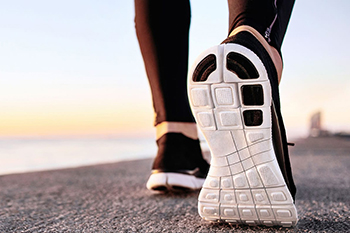
The movements that are done by walking and running are very different. People who enjoy running will often buy shoes that are different from those who like to walk. One of the main differences between these two types of shoes is the soles. Running shoes have a thicker heel area and a stiffer sole, which provides adequate stability while remaining lightweight. In comparison, walking shoes have a sole that is flexible and heels that are heavier. The materials that comprise running shoes are made of breathable fabrics, and this is to accommodate sweaty feet that can occur while running. Substantial material is often used when constructing walking shoes, and the heel is tilted so the feet can retain an angle while landing on the ground. Extra padding can be found in running shoes, despite being lighter in weight than most other footwear. If you are interested in pursuing walking or running as a sport or hobby, it is strongly advised that you consult with a podiatrist who can guide you toward what type of shoes to purchase.
For more information about walking shoes versus running shoes, consult with Dr. Douglas Mckay from New Jersey . Our doctor can measure your feet to determine what your needs are and help you find an appropriate pair of footwear.
Foot Health: The Differences between Walking & Running Shoes
There are great ways to stay in shape: running and walking are two great exercises to a healthy lifestyle. It is important to know that running shoes and walking shoes are not interchangeable. There is a key difference on how the feet hit the ground when someone is running or walking. This is why one should be aware that a shoe is designed differently for each activity.
You may be asking yourself what the real differences are between walking and running shoes and the answers may shock you.
Differences
Walking doesn’t involve as much stress or impact on the feet as running does. However, this doesn’t mean that you should be any less prepared. When you’re walking, you land on your heels and have your foot roll forward. This rolling motion requires additional support to the feet.
Flexibility – Walking shoes are designed to have soft, flexible soles. This allows the walker to push off easily with each step.
If you have any questions, please feel free to contact one of our offices located in Caldwell, and Galloway, NJ . We offer the newest diagnostic and treatment technologies for all your foot care needs.
Benefits of Foot Therapy
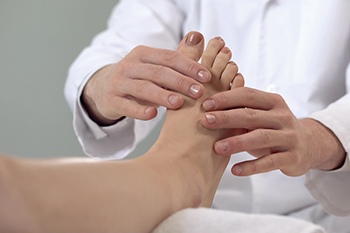 Foot therapy can be a relaxing and rewarding experience. It falls into two categories consisting of foot massages and reflexology. The latter is done by stimulating the energy channels in the body by touching the feet in specific areas. There are parts of the foot that are connected to various organs and bones and can interact with the tissues in the feet. When a foot massage is given, it is generally more direct and may be helpful in relieving tight muscles. Additionally, circulation may be improved, and existing soreness may be reduced. Many people enjoy having reflexology performed on them as it can bring positive feelings to the overall body. The digestive system may be improved in addition to having increased energy. If you would like to know more information about the benefits of foot therapy, please confer with a podiatrist .
Foot therapy can be a relaxing and rewarding experience. It falls into two categories consisting of foot massages and reflexology. The latter is done by stimulating the energy channels in the body by touching the feet in specific areas. There are parts of the foot that are connected to various organs and bones and can interact with the tissues in the feet. When a foot massage is given, it is generally more direct and may be helpful in relieving tight muscles. Additionally, circulation may be improved, and existing soreness may be reduced. Many people enjoy having reflexology performed on them as it can bring positive feelings to the overall body. The digestive system may be improved in addition to having increased energy. If you would like to know more information about the benefits of foot therapy, please confer with a podiatrist .
Foot therapy is often necessary for those recovering from either foot deformities or foot injuries. If you have concerns regarding therapy, consult with Dr. Douglas Mckay from New Jersey . Our doctor can provide the care you need to keep you pain-free and on your feet.
Most Common Injuries
People who are active or athletes are prone to a variety of injuries. Therefore, it is often important to take part in physical therapy in order to quickly get back on the right track.
What to Do When Injured
Physical Therapy – This specialized treatment will focus on the affected area, speeding up recovery and the overall healing process. It is a proven method that has helped millions of people return from any injury.
During physical therapy you will undergo regimented training to get back into full form. Training is often very difficult, especially at first when the foot feels weak. Physical therapy often involves:
Basic stretching and twisting exercises – getting the feet’s mobility and flexibility up.
Massaging – the therapist will massage the injured area in order to activate the muscles and relax them.
Strengthening Exercises – this allows the muscles in the affected area to regain their full strength, a vital step towards full recovery.
If you have any questions please feel free to contact one of our offices located in Caldwell, and Galloway, NJ . We offer the newest diagnostic tools and technology to treat your foot and ankle needs.
It's Time for Beautiful Feet
Ways Seniors Can Prevent Falling

Preventing a fall is paramount for seniors, and luckily experts can recommend a number of ways to do just that. Fall-proofing the home environment is first on the list. Start by decluttering floors and narrow hallways, and choose chairs that are stable. Avoid sitting on low chairs, sofas, folding chairs, and chairs on wheels that may affect your balance. Install nightlights in hallways and lamps beside your bed, as well as adding grab bars in tub and shower areas. Remove throw rugs or loose carpeting. Other fall prevention tips include wearing shoes with non-skid soles, avoiding loose clothing that may get caught on something, and going barefoot or wearing just socks when walking in the house. Further, it’s a good idea to review medications for side-effects, such as dizziness or drowsiness, that may contribute to a fall. Having eyeglasses prescriptions updated is recommended. If you have neuropathy, arthritis, or any other foot and ankle conditions that affect your stability when standing or walking, please visit a podiatrist for information on walking aids or devices that may help.
Preventing falls among the elderly is very important. If you are older and have fallen or fear that you are prone to falling, consult with Dr. Douglas Mckay from New Jersey . Our doctor will assess your condition and provide you with quality advice and care.
Every 11 seconds, an elderly American is being treated in an emergency room for a fall related injury. Falls are the leading cause of head and hip injuries for those 65 and older. Due to decreases in strength, balance, senses, and lack of awareness, elderly persons are very susceptible to falling. Thankfully, there are a number of things older persons can do to prevent falls.
How to Prevent Falls
Some effective methods that older persons can do to prevent falls include:
- Enrolling in strength and balance exercise program to increase balance and strength
- Periodically having your sight and hearing checked
- Discuss any medications you have with a doctor to see if it increases the risk of falling
- Clearing the house of falling hazards and installing devices like grab bars and railings
- Utilizing a walker or cane
- Wearing shoes that provide good support and cushioning
- Talking to family members about falling and increasing awareness
Falling can be a traumatic and embarrassing experience for elderly persons; this can make them less willing to leave the house, and less willing to talk to someone about their fears of falling. Doing such things, however, will increase the likelihood of tripping or losing one’s balance. Knowing the causes of falling and how to prevent them is the best way to mitigate the risk of serious injury.
If you have any questions, please feel free to contact one of our offices located in Caldwell, and Galloway, NJ . We offer the newest diagnostic and treatment technologies for all your foot care needs.
Obesity and Plantar Fasciitis
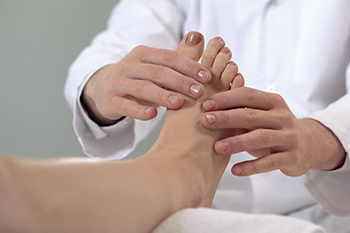
There are medical conditions that can arise from being obese. Plantar fasciitis is one such ailment that affects the heel and arch of the foot. The band of tissue that runs along the soles is called the plantar fascia and can become strained from enduring additional weight. The feet are the foundation of the body, and it is wise to lose weight to help reduce stress on the plantar fascia. Plantar fasciitis is a foot condition that can happen when the plantar fascia becomes inflamed which may cause severe pain and discomfort. People who are obese may find it helpful to spend extra time in choosing shoes that can accommodate their feet. Shoes that have a good arch support and a slightly raised heel are best to help prevent plantar fasciitis from developing. Wearing custom-made orthotics may be an option to further reduce existing tension on the plantar fascia. If you are overweight and would like to know how to protect your feet, please consult with a podiatrist who can offer you weight management advice in addition to tips on how to protect your feet.
Obesity has become very problematic at this point in time and can have extremely negative effects on the feet. If you’re an obese individual and are concerned about your feet, contact Dr. Douglas Mckay from New Jersey . Our doctor can provide the care you need to keep you pain-free and on your feet.
Obesity and Your Feet
Since your feet are what support your entire weight when standing, any additional weight can result in pain and swelling. Being overweight is one of the main contributors to foot complications.
Problems & Complications
Extra Weight – Even putting on just a few extra pounds could create serious complications for your feet. As your weight increases, your balance and body will shift, creating new stresses on your feet. This uneven weight distribution can cause pain, even while doing the simplest tasks, such as walking.
Diabetes – People who are overweight are at serious risk of developing type-2 diabetes, which has a drastic impact on the health of your feet. As you get older, your diabetes might worsen, which could lead to loss of feeling in your feet, sores, and bruises. You could also become more prone to various infections.
Plantar fasciitis – Pressure and stress that is placed on muscles, joints, and tendons can trigger plantar fasciitis, which is an inflammation of tissue that forms along the bottom of the foot.
If you have any questions please feel free to contact one of our offices located in Caldwell, and Galloway, NJ . We offer the newest diagnostic and treatment technologies for all your foot and ankle needs.
Is My Ankle Broken?

Sometimes, an individual experiencing pain in the ankle might be unsure whether or not they have broken their ankle or whether they have developed some other foot affliction. There are several signs of a broken or fractured ankle that you ought to be aware of. Most obviously, a broken ankle can be extremely painful, particularly when putting weight on the affected foot. Additionally, when an individual has a broken ankle, the affected area might begin to bruise and exhibit discoloration, caused by leaking blood from blood vessels. Of course, getting an X-ray from a medical professional is the easiest way to know for sure whether or not you have a fractured ankle. If you suspect that you have broken your ankle, contact a podiatrist today.
Broken ankles need immediate treatment. If you are seeking treatment, contact Dr. Douglas Mckay from New Jersey . Our doctor can provide the care you need to keep you pain-free and on your feet.
Broken Ankles
A broken ankle is experienced when a person fractures their tibia or fibula in the lower leg and ankle area. Both of these bones are attached at the bottom of the leg and combine to form what we know to be our ankle.
When a physician is referring to a break of the ankle, he or she is usually referring to a break in the area where the tibia and fibula are joined to create our ankle joint. Ankles are more prone to fractures because the ankle is an area that suffers a lot of pressure and stress. There are some obvious signs when a person experiences a fractured ankle, and the following symptoms may be present.
Symptoms of a Fractured Ankle
- Excessive pain when the area is touched or when any pressure is placed on the ankle
- Swelling around the area
- Bruising of the area
- Area appears to be deformed
If you suspect an ankle fracture, it is recommended to seek treatment as soon as possible. The sooner you have your podiatrist diagnose the fracture, the quicker you’ll be on the way towards recovery.
If you have any questions, please feel free to contact one of our offices located in Caldwell, and Galloway, NJ . We offer the newest diagnostic and treatment technologies for all your foot care needs.
More...
Laser Treatment May Help Toenail Fungus
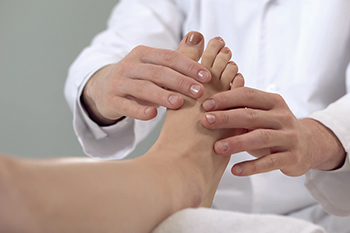
Research has shown toenail fungus may be prevalent among the elderly population. There are several methods that can be implemented to treat toenail fungus, including laser treatment. This is a procedure that has been approved by the FDA and is said that it may be effective in killing the fungus as laser beams penetrate the nail bed. It is a painless procedure and many patients have had good results, but they could vary. Toenail fungus can be unsightly, and the symptoms generally consist of yellowed, thickened nails that often become brittle with the possibility of falling off. Patients who have toenail fungus are often embarrassed by their toenails and tend to hide their feet. If you have this condition and would like more information about the pros and cons of laser treatment, it is strongly advised that you schedule an appointment with a podiatrist who can answer any questions you may have.
Laser treatment can be an effective way to get rid of toenail fungus. If you have any questions about laser treatment, consult with Dr. Douglas Mckay from New Jersey . Our doctor will assess your condition and provide you with quality treatment for fungal nails.
What Are Toenail Fungal Infections?
Onychomycosis, or fungal infection of the nail, is a relatively common and non-serious condition. Around 10 percent of U.S. citizens are afflicted with fungal nails. Common forms of fungus that infect the nail include dermatophytes, yeasts, and molds.
Symptoms of Toenail Fungal Infections Include:
- Nail thickening
- Brittleness of the nail
- Discoloration of the nail
Diagnosis for Fungal Nails
Fungal infections are diagnosed by fungal culture and microscopy. This will rule out any other conditions such as nail trauma, psoriasis, lichen planus, and onychogryphosis.
What Is Laser Treatment?
Laser treatment is a non-invasive, safe, quick, and painless procedure that uses the heat from a laser to kill fungus in the nail. Each infected nail is targeted with a laser for several minutes. The treatment is usually utilized several different times over a select period. During this time, a podiatrist will keep an eye on the infection.
If you have any questions, please feel free to contact one of our offices located in Caldwell, and Galloway, NJ . We offer the newest diagnostic and treatment technologies for all your foot care needs.
Foot Taping May Provide Relief from Painful Plantar Fasciitis
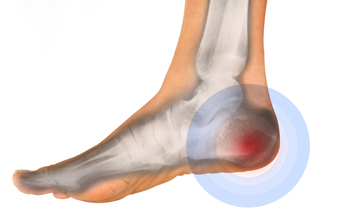
Plantar fasciitis is a form of heel pain that is quite common. It occurs when the plantar fascia tissue that connects the heel with the toes becomes damaged and sometimes torn through overuse. Plantar fasciitis causes pain and swelling in the tissue, which is worse in the morning, because the plantar fascia tissue tightens while you are sleeping. A podiatrist deals with cases of plantar fasciitis every day and has many forms of treatments to alleviate the painful symptoms of this condition. Your podiatrist may tape your foot with a rigid adhesive sports strapping tape to reduce the stretch and strain on your plantar fascia. Foot taping is a very safe treatment method, which sometimes may provide immediate relief. If you have heel pain, get your condition diagnosed by a podiatrist and discuss whether foot taping might be an appropriate treatment method.
Plantar fasciitis can be very painful and inconvenient. If you are experiencing heel pain or symptoms of plantar fasciitis, contact Dr. Douglas Mckay from New Jersey . Our doctor can provide the care you need to keep you pain-free and on your feet.
What Is Plantar Fasciitis?
Plantar fasciitis is the inflammation of the thick band of tissue that runs along the bottom of your foot, known as the plantar fascia, and causes mild to severe heel pain.
What Causes Plantar Fasciitis?
- Excessive running
- Non-supportive shoes
- Overpronation
- Repeated stretching and tearing of the plantar fascia
How Can It Be Treated?
- Conservative measures – anti-inflammatories, ice packs, stretching exercises, physical therapy, orthotic devices
- Shockwave therapy – sound waves are sent to the affected area to facilitate healing and are usually used for chronic cases of plantar fasciitis
- Surgery – usually only used as a last resort when all else fails. The plantar fascia can be surgically detached from the heel
While very treatable, plantar fasciitis is definitely not something that should be ignored. Especially in severe cases, speaking to your doctor right away is highly recommended to avoid complications and severe heel pain. Your podiatrist can work with you to provide the appropriate treatment options tailored to your condition.
If you have any questions please feel free to contact one of our offices located in Caldwell, and Galloway, NJ . We offer the newest diagnostic and treatment technologies for all your foot and ankle needs.
Heel Pain Can Be Treated!
Relief Tips for Standing All Day
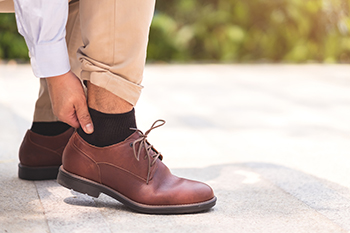
People who work on their feet daily may find their ankles are swollen at the end of the day. This may be a result of circulation issues and wearing compression socks can help to relieve some of the swelling. Some people choose to wear compression ankle braces which may be less conspicuous, and the benefits are often the same as wearing compression stockings. People who stand for most of the day may benefit from standing on a stress mat. This is helpful in decreasing the impact a concrete floor may have on your feet. A foot roller can make the soles of the feet feel better since it replicates a foot massage. Additionally, a heated foot massager may help people with flat feet or who stand all day as it can increase circulation. If you have any questions about how to pamper your feet after working all day, please confer with a podiatrist who can help you.
While working on the feet, it is important to take the proper care of them. For more information about working on your feet, contact Dr. Douglas Mckay from New Jersey . Our doctor will treat your foot and ankle needs.
Working on Your Feet
Standing on your feet for long periods of time can cause stress and pain in your feet. Your whole body may experience change in terms of posture, back pain, bunions, callouses and or plantar warts. There are ways to avoid these conditions with proper foot care, smart choices and correct posture.
Positive Changes
Negative heeled shoe – Choosing this shoe type places the heel slightly lower than the ball of the foot. These are great for overall foot health. Find shoes that fit you correctly.
Go barefoot – Our feet were not designed to be enclosed for all hours of the day. Try to periodically expose your feet to air.
Eliminate Pain
Foot Exercises – Performing simple exercises, incorporating yoga and doing stretches are beneficial. This will allow increased blood flow to the area and muscles of the foot.
Achilles tendon – Stretching the foot out flat on the floor will relax the calf muscles and tendon. These exercises can be performed almost anywhere. Make sure you add these exercises to your daily regimen.
With a little bit of this information and knowing more about foot health, you will notice changes. Foot stretches and proper footwear will help with pain and prevent further issues.
If you have any questions please feel free to contact one of our offices located in Caldwell, and Galloway, NJ . We offer the newest diagnostic and treatment technologies for all your foot and ankle needs.




